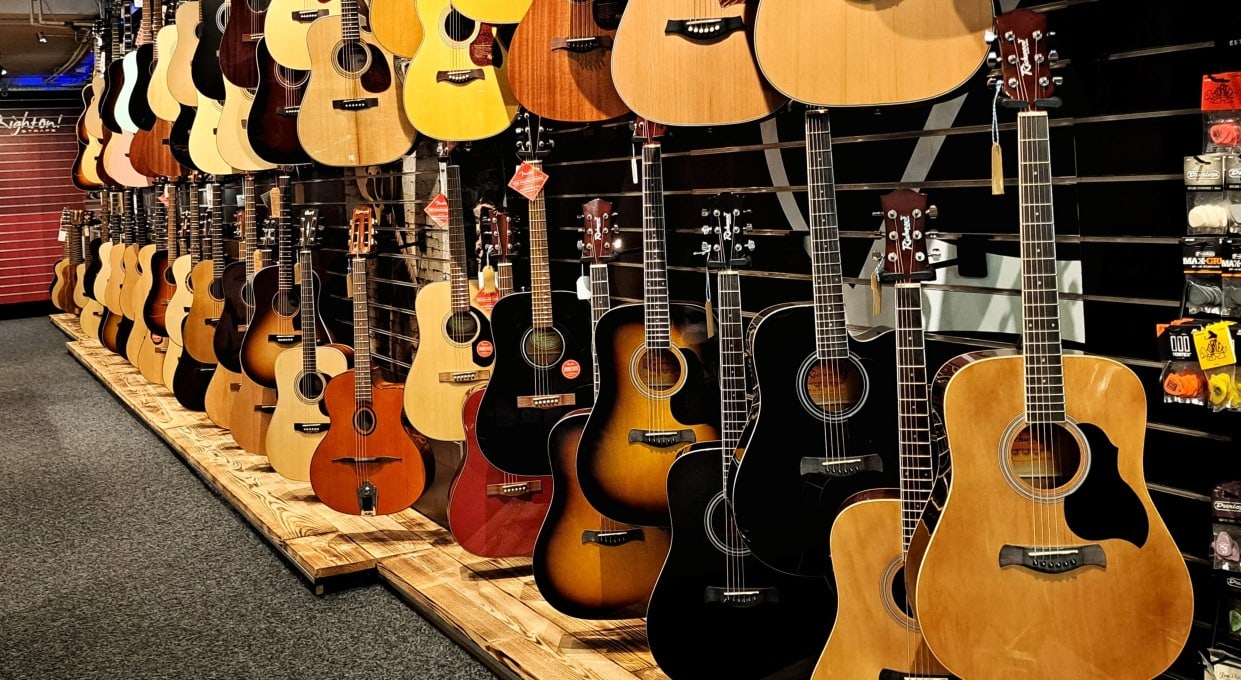The very first thing you’ll note walking into a guitar store is the wide variety of body sizes they come in. The options range from quaint parlors to larger-than-life jumbos. Each size affects the guitar’s overall sound and volume.
When it comes to acoustic guitars, important measurements for playability are length, depth, and lower bout. Bouts are the main body curves. The upper bout is the smaller curve near the neck. While the lower bout is the larger curve that makes up the bulk of the body. Between these is the waist.
We’ll explore the common sizes of acoustic guitars, and how their different sizes can support players for a wide range of playing styles and needs.
Table of Contents
- Parlor/Travel-Sized Acoustic Guitars
- Concert-Sized Acoustic Guitars
- Orchestra/Auditorium-Sized Acoustic Guitars
- Dreadnought-Sized Acoustic Guitars
- Jumbo-Sized Acoustic Guitars
- How Do You Select the Perfect Guitar Size for Your Needs?
- Guitar Postures Explained
- Scale Length and String Tension
- Neck Width and Shape
- Body Depth and Shape
- A Brief Note on Tonewoods
- Different Guitars for Different Environments
- A Matter of Personal Preference
Parlor/Travel-Sized Acoustic Guitars
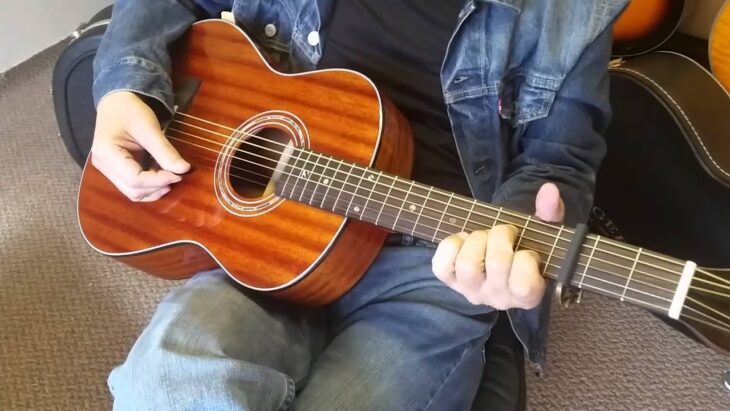
These are the smallest adult-sized guitars. Their compact size makes them the ideal choice for traveling musicians or those with smaller physiques. Despite their size, they produce a clear and articulate sound, typically emphasizing the midrange frequencies.
- Body length – less than 18” (45cm)
- Depth – 3.75” (9.5cm)
- Lower bout – 13” (33cm)
Parlor guitars seem to look “stretched” with a greater length ratio. This allows for a larger soundboard to give more volume for the size, whilst remaining comfortable to play for smaller players.
Their diminutive size doesn’t mean that they aren’t a good choice for busking or live gigs. Many manufacturers produce clip-in acoustic pickups that allow these smaller-scale guitars to be amplified to stadium volumes. Even then, you will find some of these models that will happily fight it out with the larger players.
Famous parlor guitar players include: Robert Johnson (Gibson L1), John Mayer (Martin OMJM)
Notable options include:
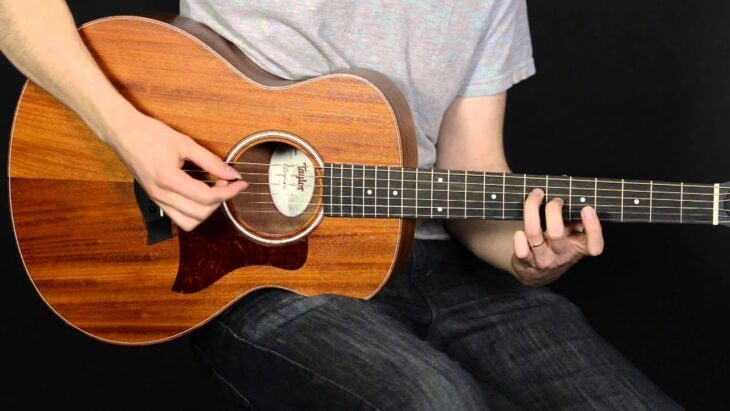
- Taylor GS Mini — This guitar stands out because of its impressive sound and portable size. Despite its compact form, it delivers a robust tone and a wide dynamic range.
- PRS SE P50 — Well noted for its vintage aesthetic and quality construction, offering a balanced and responsive sound.
- Epiphone L00 — Another popular choice renowned for its bright, clean tone and comfortable body size. An excellent choice for blues or folk music.
Concert-Sized Acoustic Guitars
This guitar size offers a middle ground, bridging the gap between the smaller Parlor size and larger guitars. They feature a louder voice than parlor models, with a wider tonal range.
- Body length – 18” (45cm)
- Depth – 4.25” (11cm)
- Lower Bout – 13.5” (34cm)
The bout (upper/lower) ratio is increased compared to other sizes. This provides a firm tone that emphasizes individual notes well. This lends itself more to finger-picking styles than strumming.
Concert-sized acoustic guitars are playable in intimate environments without further amplification. There is a wide range of excellent acoustic pickups that can be used without being too invasive to the guitar’s natural tones.
Famous concert guitar players include James Taylor (Olson James Taylor), Andrés Segovia (Ramirez)
Notable options include:
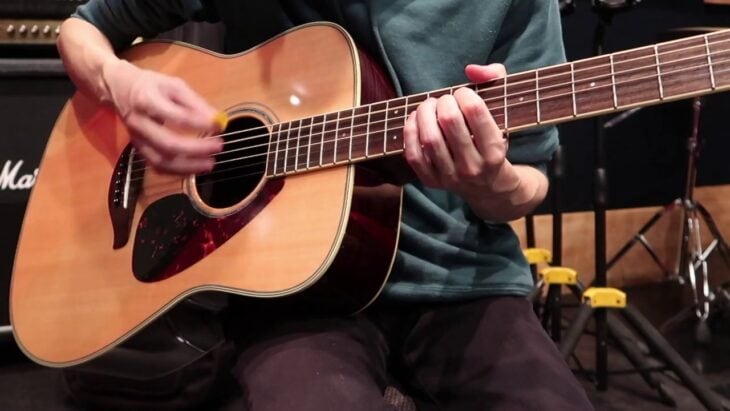
- Yamaha FS800 — A standout instrument, appreciated for its affordable price and robust sound. Its smaller body size provides a comfortable playing experience without compromising on sound quality.
- Guild OM-240E — Offering a balanced tone and excellent resonance because of its arch-back design.
- Martin 00-15M — Known for its all-mahogany construction, delivers a warm, rich tone, marking it as a favorite among many guitarists.
Orchestra/Auditorium-Sized Acoustic Guitars
The orchestra/auditorium-sized acoustic guitars employ a similar elongated soundboard to produce great volumes for their playable size.
- Body length – 18 ⅞” (48cm)
- Depth – 4 ⅛” (10.5cm)
- Lower Bout – 14 ⅓” (36.5cm)
The orchestra/auditorium-sized guitar is the all-rounder of our group. Equally adept at finger-picking and strumming. These are the workhorses of many famous guitarists for their acoustic work.
This size is more than capable of standing up to playing alongside pianos, gentle strings, and light percussion. If this size fits your body and playing style, then this size makes a perfect “only” acoustic guitar.
Famous auditorium guitar players include Eric Clapton (Martin 000-28EC) and Rodrigo y Gabriela (Yamaha NX Series).
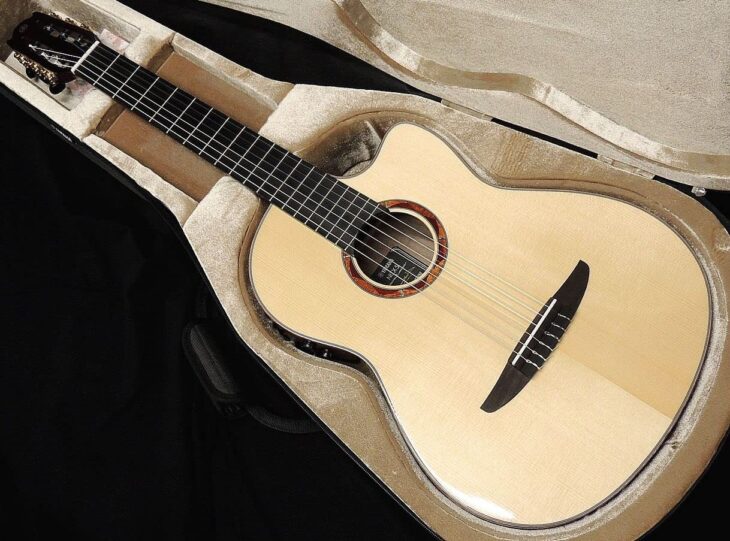
Notable options include:
- Taylor 214ce — Known for its bright and balanced tone, it also features a cutaway design for easier access to higher frets.
- Alvarez AGE95CESHB — Combining aesthetic appeal with sonic performance, to provide a balanced, vibrant sound.
- Washburn Heritage Series HG12S — This guitar features a solid mahogany top. This offers a warm, well-rounded tone suitable for various music styles.
Dreadnought-Sized Acoustic Guitars
This is the size that everybody believes they want to play. It is under the arms of many a famous guitarist and is the true battleship for knocking out powerful chords.
With a fairly shallow waist compared to the bouts, this provides the space to make a robust tone. With this size of guitar you can expect to produce a lot more bass, lending them to being played alone far more than the smaller sizes.
- Body Length – 19 ⅞” (50cm)
- Depth – 4 ¾” (12cm)
- Lower Bout – 15 ⅝” (40cm)
While strumming is the genuine spirit of a dreadnought, their longer neck leads to them being fairly versatile for playing melodic lines too.
These larger sizes can be prohibitive to many guitarists simply because of their bulk. As a small guitarist myself, I can play dreadnoughts but tire easily. On dreadnoughts, I find it difficult to maintain a comfortable playing stance for longer periods of time.
Famous dreadnought guitar players include Keith Richards (Martin D28) and Johnny Cash (Martin D35).
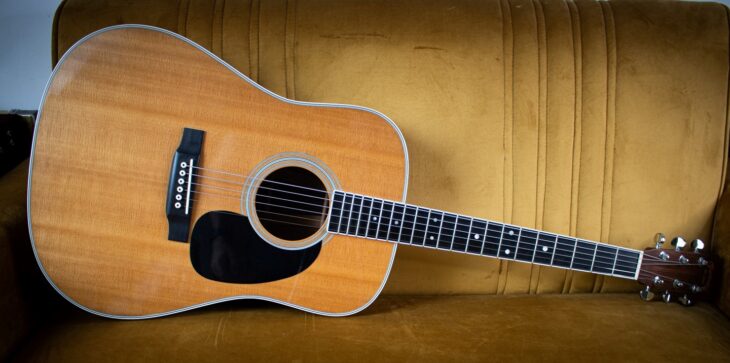
Notable options include:
- Martin D-15M — With its all-mahogany construction, it is a popular choice, delivering a warm, resonant sound perfect for strumming.
- Takamine P3DC — Offering a rich and complex tone with its solid cedar top and sapele back and sides.
- Fender CD-140SCE — Known for its impressive sound quality and affordability, is a versatile choice suitable for varied playing styles.
Jumbo-Sized Acoustic Guitars
These are the true bad boys. If you are simply massive and want to belt out the big stuff, then this is your playground. I have never played a Jumbo guitar. I doubt I ever will. At 167cm, it would simply swamp me.
If you have arms like Sasquatch, then you will definitely fare better than me. The dimensions are simply biblical!
- Body length – 20 ⅝” (52.5cm)
- Depth – 4 ¾” (12cm)
- Lower Bout – 17 ¼” (44cm)
Jumbo guitars are cannons. They fire out massive chords and compete with pianos and lower-amplified electric instruments. You can play this with your band at a club gig and potentially not need amplification.
Famous jumbo guitar players include Bob Dylan (Gibson SJ-200) and Noel Gallagher (Gibson J-150).
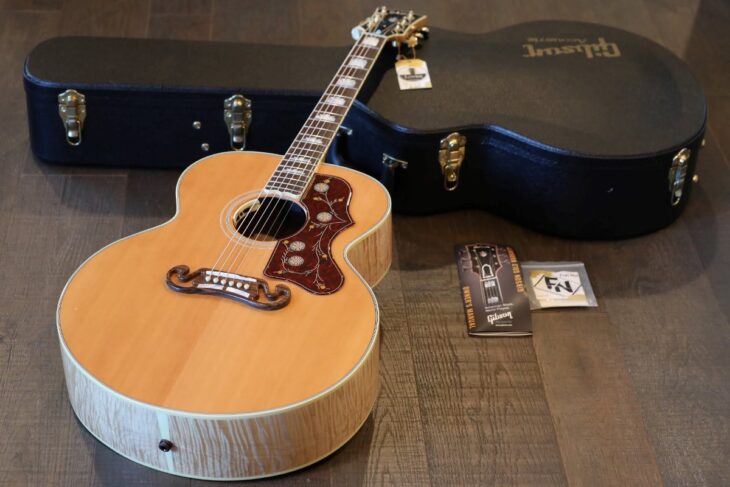
Notable options include:
- Guild Guitars F-250E — This is a standout model in this category, providing a robust sound and excellent projection.
- Gretsch G5022CE Rancher — This guitar offers a booming, full-bodied tone because of its solid spruce top and scalloped X bracing.
- Sawtooth Maple Series — Another popular choice. Delivers a rich tone and an appealing aesthetic. It is a favored choice among performers seeking sound quality and visual appeal.
How Do You Select the Perfect Guitar Size for Your Needs?
With all that information in place, I now turn to you, the player. I want you to walk into that guitar shop ready and prepared to make a good choice for your needs. Let’s take you through postures, scale lengths, necks, bodies, and tonewoods to help you pair down your choices.
Guitar Postures Explained
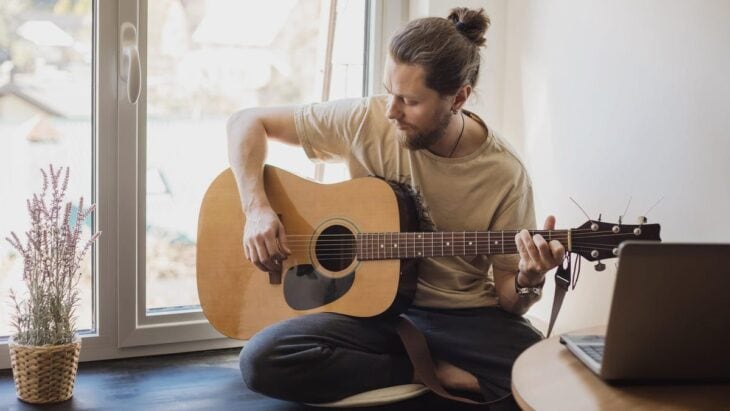
We are all too used to seeing guitarists looking super cool with their guitars slung low down near their knees. Luckily, with acoustic guitars, there is none of this rock-star posturing to be concerned about. Your choice of position when playing will, however, go a long way to helping you decide on what acoustic guitar will work best for you.
To get a good idea, it is best to play in the traditional position first. Seated, with the left leg slightly higher than the right. The guitar rests on the thigh with the neck pointing upwards at 30 degrees. This position allows the freedom of movement required and stops your arm from stretching over the bulk of the body in an uncomfortable position.
It is this position that will teach you the most about how your acoustic guitar will work for you. If you stand with the guitar strapped to you, you will use this position too.
On more relaxed days you will lay back and let the guitar sit on your torso, during friendly jam sessions you will let it lay across your lap. This position will not give you easy high-fret access, but if you’re just smashing out chords as loud as you can, this is not a big deal.
For trying out acoustics? Try to use the traditional position to be sure you get a good idea of whether you can play the neck scale correctly. You will also discover whether the body type will be comfortable long-term.
Scale Length and String Tension
The scale length, or the distance from the nut to the bridge, might seem like a minute detail. Yet it is crucial in determining the guitar’s string tension and fret spacing.
Longer scale lengths create more tension, providing a tighter feel. If you love playing with alternate tunings as I do, a guitar with a longer scale length can be a great asset. They bring out the best in your notes, giving them that extra punch.
This extra tension and the larger body type that accompanies longer necks provide a percussive punch to your strumming. This allows the guitar to stand on its own.
Shorter scale lengths, however, are another experience. They result in less tension, which can be quite beneficial for players with smaller hands or those who prefer a more relaxed, looser feel to their strings.
These shorter-scale necks allow more intricate movement on the neck and provide the scope for pitch-bending strings without having to have Arnie’s fingers!
Neck Width and Shape
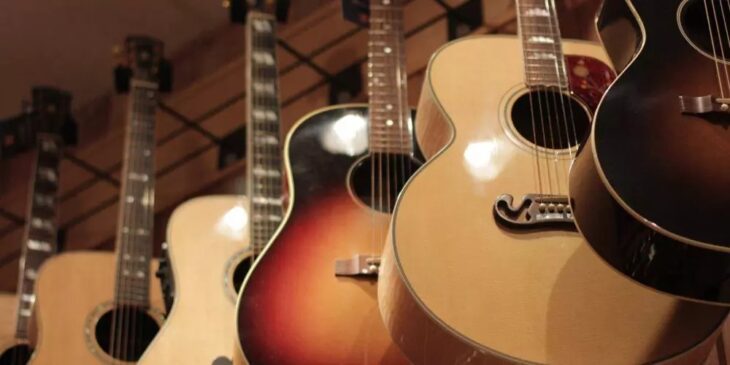
Not acoustic, but relevant. I have never got on with Les Paul guitars. This is a shame, as one of my early guitar heroes is Jimmy Page. Whilst he might have used a Telecaster on some recordings, almost all the iconic images of him are with a low-strung Les Paul.
Why could I not get on with them? Neck size. I’m not a large man and my hands are not club-like either. Holding the neck of a Les Paul felt like I was trying to perform intricate hand gymnastics on a cricket bat.
When you dive into the world of guitar necks, both the width and shape become significant. They influence the comfort and playability of the instrument, affecting your performance’s fluidity.
A wider neck is often a favorite among finger-style players. It provides more room for intricate fingerpicking, allowing for more detailed fretting. As someone who occasionally likes to indulge in finger-style playing, I can vouch for the precision it allows.
However, if you’re someone with smaller hands or primarily strum chords, a guitar with a narrower neck might be a better fit. The important thing is that the guitar should extend your body, mirroring your movements and playing style.
Over the years, I have realized that my preference is almost always for a wider, yet flatter, neck. This allows my smaller hands to cope with the neck whilst giving me adequate string space to move about with speed and accuracy.
Other players prefer the chunky neck as it provides grip and allows them to churn out massive chords all night long.
Make sure you try a variety of neck shapes and think about how you will play your new acoustic guitar.
Body Depth and Shape
The depth of a guitar’s body helps to contribute to the tone and resonance of the instrument.
Deeper bodies usually produce a more pronounced bass response, creating a rich, full-bodied sound that fills up a room. These guitars bring warmth to your music, accentuating the lower frequencies and adding depth to your melodies.
On the flip side, shallower bodies lean towards the mid-range and treble. They produce a more articulate tone that stands out in a mix. They’re great when you want your guitar to cut through other instruments, creating a bright, pronounced sound.
Deeper bodies can cause issues for smaller players, particularly when seated. Whilst shallower bodies have less punch when not amplified.
A note of warning. I have owned an Ovation. It was one of my guitar goals. In the shop, I played it standing up using a strap. It was amazing. Great neck, beautiful sound, pretty thing, and is easy to amplify. Once I owned it, I wanted to sit down with it. That was when I realized it is nearly impossible to sit with a bowl-backed guitar.
Since round-back guitars still aren’t that common, here’s a dedicated article on our site about them, if you’re curious.
Make sure you try your prospective guitars in the positions you hope to play them. Ask for the shop to provide a strap if the guitar supports it. See if you can find comfortable positions, both seated and standing.
A Brief Note on Tonewoods
Whilst this article is about the right size of acoustic guitar, it is worth mentioning the woods used in construction briefly. If only to make this a slightly more complete buyer’s guide.
The tonewoods used to construct the instrument produce varying tones, each adding its unique color to your sound.
For example, we know mahogany for its warm, full-bodied sound with an emphasis on mid-range frequencies. Rosewood offers a balanced tone with rich lows and bright highs. Maple, one of my personal favorites, provides a bright, focused tone ideal for live performances.
The choice of tonewood should align with the sound you aim to produce and the music genre you lean towards.
Different Guitars for Different Environments
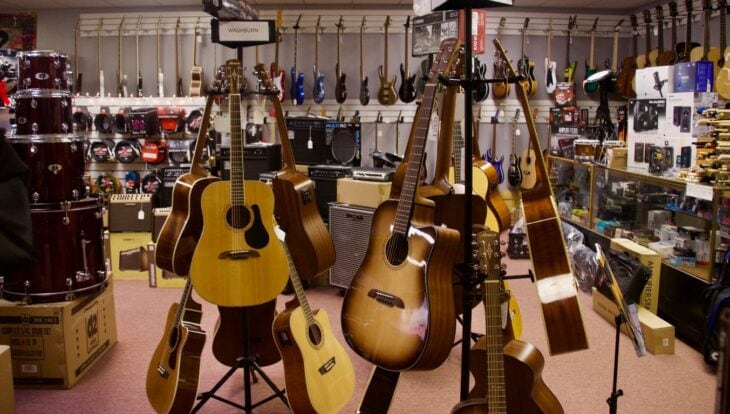
One of the final factors to consider when choosing an acoustic guitar based on size is where you’ll be playing it. Each guitar size and style can serve a unique environment.
If you’re playing at home, smaller guitars like parlors or grand concerts can be great. They have a focused sound that doesn’t overwhelm the room. With the right pickup and amplifier combination, you can also take these guitars to your gigs.
For busking, a medium-sized guitar like a dreadnought is my go-to choice. It’s loud enough to cut through the noise of the streets, yet portable enough to carry around. Don’t forget the hard case. People need somewhere to throw their money.
For concerts, larger guitars like jumbos or grand auditoriums excel. They have the volume and resonance to carry your music to every corner of the venue. And if you’re playing live and plan to amplify your guitar, larger guitars offer more tonal depth and range when amplified.
A Matter of Personal Preference
Ultimately, the choice of guitar size should be guided by your preference and playing style. Consider the genre of music you want to play, your physical attributes, and any specific requirements you have.
This is something I’ve learned from experience. You could have the most expensive guitar in the world, but if it doesn’t match your style or feel comfortable playing, it’s not the right fit.
I have had the joy of playing many acoustic guitars. For owning I prefer smaller models that I can relax with. This is vital for those times when you just lay back and noodle or smash out chords. Comfort is key for the creativity process, so I favor my Taylor GS Mini.
Outside of home comforts. I have been lucky enough to play a range of guitars. Even though I wanted to love the Gibson J45, it was simply too big for me to stay comfortable with. The Gibson L00, however, is the one acoustic that I would happily buy… if I had the money.
Now you are better armed to go out there and get amongst them. Try to not be drawn by price, reputation or any other factor. Find comfort, tone, and a responsiveness to your playing style. You will love this instrument for many years to come.

